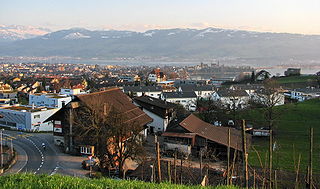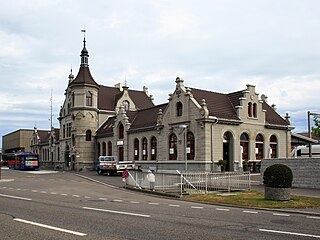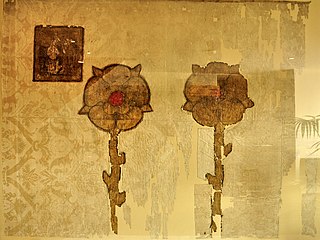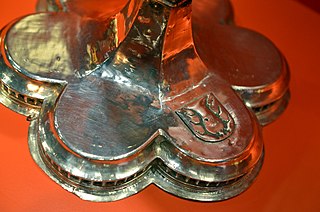Bollingen is a village (Kirchdorf) within the municipality of Rapperswil-Jona in the Swiss canton of St. Gallen.
Contents






Bollingen is a village (Kirchdorf) within the municipality of Rapperswil-Jona in the Swiss canton of St. Gallen.






The village is located along the northern shore of the upper Lake Zürich (Obersee) between Jona and Schmerikon. Bollingen was part of the former municipality of Jona: On 1 January 2007 the former municipalities of Rapperswil and Jona merged to form the new political entity Rapperswil-Jona.
Sandstone from Bollingen may have been used even in the Roman Empire era, but presumably Bollinger Sandstein is extracted and processed since 1000 AD. Among others it was used for the Grossmünster and Fraumünster churches in Zürich, as well as for the Einsiedeln and St. Gallen abbeys, [1] or the Zunfthaus zur Meisen that was built in 1757 at the Münsterhof plaza in Zürich. [2]
In the European Middle Ages, the two settlements named Unterbollingen and Oberbollingen are mentioned as part of the later Herrschaft Rapperswil of the Counts of Rapperswil. The earliest document sealed at the Rapperswil Castle was related to the donation of the church of Unterbollingen to the Rüti Abbey, and also mentions among others a civitas of the town of Rapperswil as witnesses of Count Rudolf von Rapperswil in 1229. [3] On the peninsula at Oberbollingen, a St. Nicholas Chapel is mentioned, where around 1229 a small Cistercian nunnery, later Premonstratensian convent associated with the Rüti Abbey was established by the Counts of Rapperswil; in 1267 it was united with the nearby Mariazell Wurmsbach Abbey. In 1519 a new church in honor of St. Pancras was inaugurated in Unterbollingen. After the Reformation in Zürich the church was acquired by the city of Rapperswil to be united with the Heiliggeistspital, but since 1871 it is a parish church for its own.
Bollingen is known for the "Tower" built there by Carl Gustav Jung. Another remarkable site is the nearby Wurmsbach Abbey.
Bollingen was a railway station located about halfway between Bollingen village and the Wurmsbach Abbey, which closed in 2004 for economic reasons. It is located on the Rapperswil–Ziegelbrücke railway line in between Blumenau and Schmerikon stations. The railway building remained, but the platforms have been removed.
Since railway services were suspended, public transport was reduced to a bus service. Until December 2023, bus line 621 operated between Rapperswil and Buech/St. Dyonis (closest bus stop is Buechstr. West, a ca. 30 minute walk away from Bollingen village). [4] Line 621 was subsumed into line 995, operated by Schneider Busbetriebe . [5] The route was shortened and the western terminus became Jona. As of December 2023, the bus route is as follows:
| Line | Route | Operator |
|---|---|---|
| 995 | Jona railway station – Jona Center – Hummelberg/Jona, Buechstrasse Ost | Schneider Busbetriebe |

Lake Zurich is a lake in Switzerland, extending southeast of the city of Zürich. Depending on the context, Lake Zurich or Zürichsee can be used to describe the lake as a whole, or just that part of the lake downstream of the Hurden peninsula and Seedamm causeway. In the latter case, the upstream part of the lake is called Obersee, whilst the lower part is sometimes also referred to as the Lower Lake, respectively.

Rapperswil-Jona is a municipality in the Wahlkreis (constituency) of See-Gaster in the canton of St. Gallen in Switzerland. Besides Rapperswil and Jona, which were separate municipalities until 2006, Rapperswil-Jona also includes Bollingen, Busskirch, Curtiberg, Kempraten-Lenggis, and Wagen.

Wurmsbach Abbey is a monastery of Cistercian nuns located in Bollingen, a locality of Rapperswil-Jona, in the Canton of St. Gallen, Switzerland. It is located on the north shore of upper Lake Zürich. The house is a part of the Order of Cistercians of the Common Observance (O.Cist.).

The counts of Toggenburg ruled the Toggenburg region of today's canton of St. Gallen, Switzerland, and adjacent areas during the 13th to 15th centuries.

Jona is a former municipality and since January 2007 part of the municipality of Rapperswil-Jona in the Wahlkreis (constituency) of See-Gaster in the canton of St. Gallen in Switzerland. Before the merger with Rapperswil, the former municipality of Jona comprised the villages of Jona, Bollingen, Busskirch, Curtiberg, Kempraten-Lenggis, and Wagen.

Rapperswil is a former municipality and since January 2007 part of the municipality of Rapperswil-Jona in the Wahlkreis (constituency) of See-Gaster in the canton of St. Gallen in Switzerland, located between Obersee and the main part of Lake Zurich.

Kempraten-Lenggis is a village (Kirchdorf) within the municipality of Rapperswil-Jona, Wahlkreis (constituency) of See-Gaster in the canton of St. Gallen in Switzerland. The remains of the Gallo-Roman settlement Centum Prata are one of the most important archaeological sites in the canton of St. Gallen; Centrum Prata is located at the so-called Kempratnerbucht, in Rapperswil and Busskirch on Zürichsee lake shore.

Rapperswil Castle is a castle, built in the early 13th century by the House of Rapperswil, in the formerly independent city of Rapperswil.

Rapperswil railway station is located next to the old town and harbour of Rapperswil in the Swiss canton of St. Gallen. It is the largest of four active railway stations in the municipality of Rapperswil-Jona. Rapperswil railway station is situated on the north shore of Lake Zürich at the northern end of the Seedamm, which separates the Obersee from the main body of the lake.

Heilig Hüsli is a bridge chapel in Rapperswil, Canton of St. Gallen, Switzerland.

Rathaus Rapperswil is the former Rathaus of the city government of medieval town of Rapperswil, Canton of St. Gallen in Switzerland. Today, the building houses a café and restaurant, the city archives and a collection of stained glass windows, silverware and paintings. The building and the city archives are listed in the Swiss inventory of cultural property of national and regional significance.

Rüti Monastery was a former Premonstratensian monastery, founded in 1206 and suppressed in 1525 on occasion of the Reformation in Zürich, situated in the municipality of Rüti in the canton of Zürich, Switzerland. The monastery's church was the final resting place of the Counts of Toggenburg, among them Count Friedrich VII and 13 other members of the Toggenburg family, and other noble families. Between 1206 and 1525, the monastery comprised 14 incorporated churches and the owner of extensive lands and estates at 185 localities.

The House of Rapperswil respectively Counts of Rapperswil ruled the upper Zürichsee and Seedamm region around Rapperswil and parts of, as of today, Swiss cantons of St. Gallen, Glarus, Zürich and Graubünden when their influence was most extensive around the 1200s until the 1290s. They acted also as Vogt of the most influential Einsiedeln Abbey in the 12th and 13th century, and at least three abbots of Einsiedeln were members of Rapperswil family.

Elisabeth von Rapperswil was the last countess of the House of Rapperswil, and secured by her second marriage the female line of the Counts of Rapperswil and the extensive possessions of Rapperswil in the former Zürichgau to the Laufenburg line. Her son by first marriage was Reichsvogt Wernher von Homberg, and her oldest son by second marriage was Count Johann von Habsburg-Laufenburg who passed over the title of the count of Rapperswil to his oldest son Johann II and his brothers Rudolf and Gotfried.

The Obersee is the smaller of the two parts of Zürichsee in the cantons of St. Gallen and Schwyz in Switzerland.

Buechberg is an elongated molasse hill in the Swiss cantons of Schwyz and St. Gallen on Obersee lakeshore.

Elisabeth von Matsch was the last countess of the Swiss noble House of Toggenburg from 1436. She was the spouse of Friedrich VII, count of Toggenburg.

Reformierte Kirche Rüti is an Evangelical Reformed church in the Swiss municipality of Rüti in the Canton of Zürich. It was built between 1214 and 1219 AD as the Romanesque style church of the then Premonstratensian Kloster Rüti, an abbey that was founded in 1206 by the House of Regensberg and suppressed in 1525 as part of the Reformation in Zürich.

Bollinger Sandstein or Bollingen Sandstone is a sandstone found on Obersee lake shore, namely between Bollingen and Uznach and Buechberg area, in the cantons of St. Gallen and Schwyz in Switzerland.

The Rapperswil–Ziegelbrücke railway line is a single-track standard-gauge railway line in Switzerland. It was built as part of the route from Rüti to Glarus, which was opened by the United Swiss Railways on 15 February 1859.